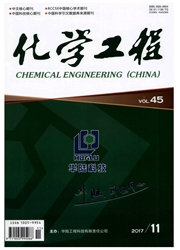

 中文摘要:
中文摘要:
在典型的熔融结晶过程中,脉冲式通入气泡是关键的操作条件之一。文中通过分析对甲酚熔体中形成的气液二相流动特点,建立了降膜熔融体系的气体通入过程中二相流流动数学模型,采用CFD技术对连续和脉冲过程中的气液二相流流场进行了数值模拟。利用气泡形态和上升速度的比较验证了模拟结果的可靠性。研究结果表明:脉冲通气形成的气液二相流的整体速度与连续通气条件下的相比较要小,但是在结晶器近壁面区域的速度却明显比连续通气条件下的大,且弹状气泡形成的速度场促进了流体的径向混合。在结晶过程中,脉冲通气形成的弹状气泡流动有利于熔体与晶体壁面之间的层流层与液相主体之间的传质和传热,从而有利于保持边界层稳定的浓度和温度梯度。
 英文摘要:
英文摘要:
Pulse-bubbling is one of the critical operating conditions in the typical melting crystallization processes. The two-phase flow model of falling-film melting system was built by analyzing the flow characteristic of gas slug in gas-liquid (p-cresol melt system ) two-phase flow. Gas-liquid two-phase flow process was simulated by CFD technique. Bubbles form and rise velocity were used to verify the reliability of the simulation result. The results show that pulse-bubbling can intensify the mass and heat transfer between melts-crystals wall laminar boundary layer and liquid bulk, and keep the stability of concentration and temperature gradient in the boundary layer, which are beneficial to p-cresol melt crystallization process. Crystal layer thickness increases with time and becomes flat finally.
 同期刊论文项目
同期刊论文项目
 同项目期刊论文
同项目期刊论文
 期刊信息
期刊信息
